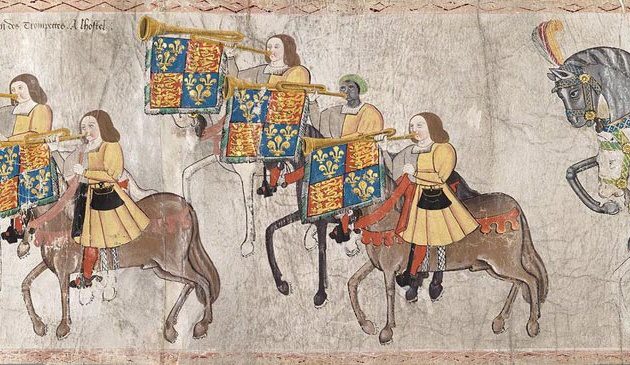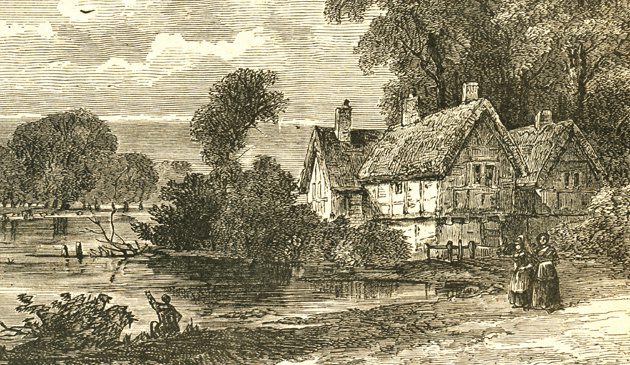London Bridge during the Tudor period

A view of London Bridge in the 16th century, looking from the south. In the foreground is the church of St. Mary Overy, which became Southwark Cathedral in the early 20th century. Between the church and the adjacent Winchester Palace is St. Saviour’s Dock, from where a ferry crossed over to Dowgate. On the southern gateway of the bridge heads can be seen on spikes. The large building overhanging the bridge with onion domes on its four corner towers is Nonesuch House. The drawing was by H.W. Brewer and appeared in ‘Old London Illustrated’ in 1921.
From the late 15th century there is mention of waterworks at London Bridge. In 1497 a pump of Flemish origin was purchased and in subsequent decades money paid for repairs to the bridge’s waterworks. A Dutch hydraulics engineer by the name of Peter Morice, employed by Sir Christopher Hatton, demonstrated to the city authorities in 1581 how water could be fed into buildings, supplying fresh water. He proved it by directing water from the Thames through lead pipes and over the steeple of St. Magnus church in Lower Thames Street. His plan was to use the flow of the river through the first arch of London Bridge on the City end to power a wheel, turning pumps that lifted water into a tank above the level of the surrounding houses. Water from the tank could then flow through pipes by gravity into the buildings. Impressed by the demonstration, the authorities granted Morice a 500-year lease at ten shillings per year to construct a water wheel-powered pump in the northern arch of the bridge. The first water to flow arrived at Leadenhall on Christmas Eve 1582, followed by Old Fish Street. It was such a success that the following year he was granted a lease for the second arch of the bridge. From there Morice was able to supply water to buildings in the surrounding area as far as Leadenhall. London’s water-bearers lobbied against Morice’s system, fearing they would be put out of work. Despite that, four waterwheels were thereafter in use at the bridge for the following two centuries. The scheme made Morice a wealthy man and his successors, who changed their name to Morris, were still receiving profits a hundred years later. In 1701 Thomas Morris was granted a lease on the fourth arch, the third having been damned up. Shortly after, they sold the enterprise, which continued until 1822.
The bridge was managed and maintained by wardens and their staff based at Bridge House on the waterside near the Southwark end of the bridge. They in turn were subservient to the Corporation of London. A centuries-old complication was that the bridge was owned by the City but partly located in the parishes of Southwark. That ended in 1550 when the Corporation purchased the lordship of Southwark, to create Bridge Ward Without. Thereafter the bridge was located entirely in the City of London.
A fire broke out at the northern end of London Bridge in February 1633 in which eighty of the old wooden houses in the parish of St. Magnus the Martyr were destroyed. It was a cold month and the river had frozen over. The fire started when a maid-servant in the house of a needle-maker left a tub of hot coal ashes under some wooden stairs before going to bed. The blaze continued unchecked across the bridge, destroying homes and workshops as it went. A commission was set up to investigate the rebuilding work and it was the opinion of King Charles I that they should not be replaced, so the northern end of the bridge remained empty of buildings for several years. It was only in 1647, by which time Charles was under arrest and not in a position to object, that rebuilding work on new houses began.
In contrast, the bridge and its dwellings were left relatively unscathed by the Great Fire of London in September 1666, which destroyed St. Magnus church and the entire area in the northern approach. Of the bridge itself, damage was limited to the first building at the northern end and the waterworks. Some repairs were necessary to piers and arches and the destroyed structure was rebuilt in 1683. Buildings at the southern end were rebuilt in a matching style. As buildings were replaced following the fires of 1633 and 1666 and at other times during the 17th century they were made to overhang the sides of the bridge. That allowed for the narrow roadway along the centre to be widened but gave the bridge a bulkier and perhaps less attractive appearance.
In 1749 London Bridge was joined across the river by a second crossing, the more modern and elegant Westminster Bridge with a wide road and convenient approaches. In comparison London Bridge looked rather sad and ancient and probably somewhat of an embarrassment to the City Corporation.
Sources include: Charles Welch ‘History of the Tower Bridge’ (1894, courtesy of the Hawk Norton collection); Peter Matthews ‘London’s Bridges’; Gustav Milne ‘The Port of Medieval London’; Caroline M.Barron ‘London in the Later Middle Ages’; John Schofield ‘London 1100-1600; Liza Picard ‘Elizabeth’s London’; John Pudney ‘Crossing London’s River’.
< Back to Bridges and Tunnels


